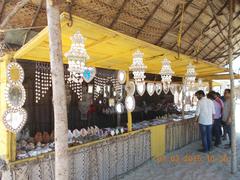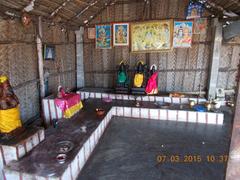
Dhanushkodi: Visiting Hours, Tickets, Historical Sites, and Essential Travel Guide
Date: 14/06/2025
Introduction
Dhanushkodi, perched at the southeastern tip of Rameswaram Island in Tamil Nadu, India, is a destination where myth, history, and natural beauty converge. Once a bustling port town, Dhanushkodi is now renowned both for its spiritual legacy—rooted in the ancient Hindu epic, the Ramayana—and its haunting ruins, a legacy of the catastrophic 1964 cyclone. Today, it stands as a unique destination for pilgrims, history enthusiasts, and travelers captivated by coastal landscapes and untold stories.
This guide brings together all the practical details you need, including visiting hours, ticket information, travel tips, and an overview of Dhanushkodi’s most significant attractions and historical sites. It also delves into the town’s mythological and cultural importance, offering a comprehensive resource for planning your journey to this unforgettable corner of India (Tusk Travel; Stamped Moments).
Contents
- Historical Overview
- Mythological and Spiritual Significance
- Colonial Era and Pre-1964 Prosperity
- The 1964 Cyclone and Aftermath
- Visiting Dhanushkodi: Practical Information
- How to Reach
- Visiting Hours and Entry
- Tickets and Fees
- Best Time to Visit
- Safety and Travel Tips
- Facilities and Amenities
- Main Attractions and Things to Do
- Local Customs, Food, and Shopping
- Frequently Asked Questions (FAQ)
- Conclusion
- Sources
Historical Overview
Mythological and Spiritual Significance
Dhanushkodi is steeped in Hindu mythology, most notably the Ramayana. It is believed to be the site where Lord Rama, with Lakshmana, Hanuman, and the Vanara army, built the Ram Setu (Adam’s Bridge) to cross over to Lanka and rescue Sita from Ravana. The name “Dhanushkodi” means “end of the bow,” referencing the spot where Rama marked the beginning of the legendary bridge (IOSR Journals). Satellite imagery and geological studies support the presence of a chain of limestone shoals between India and Sri Lanka, often linked to this myth (India Water Portal).
Dhanushkodi is also integral to the yatra (pilgrimage) circuit. Ritual bathing at the confluence of the Bay of Bengal and the Indian Ocean is considered purifying, and many devotees perform this ritual before proceeding to the Ramanathaswamy Temple in Rameswaram (Holiday Landmark).
Colonial Era and Pre-1964 Prosperity
During British rule and after, Dhanushkodi was a prosperous town, acting as a vital transit hub between India and Sri Lanka. It housed a railway terminus, customs office, post office, churches, and temples, and was the departure point for the famous Boat Mail train from Chennai (Pathbeat). The cosmopolitan town saw travelers, traders, and pilgrims from across the region (IOSR Journals).
The 1964 Cyclone and Aftermath
On December 22, 1964, a powerful cyclone destroyed Dhanushkodi. The storm, with winds up to 270 km/h and massive tidal waves, obliterated the town, killing thousands and sweeping away the Boat Mail train (Media India). Subsequently, the government declared Dhanushkodi unfit for habitation, and ferry services to Sri Lanka ceased. Today, only a handful of fishing families remain amid the ruins (India Water Portal).
Visiting Dhanushkodi: Practical Information
How to Reach
- By Air: The nearest airport is Madurai, about 170–180 km away. Taxis and buses connect to Rameswaram, from where Dhanushkodi is accessible (things.in).
- By Train: Rameswaram Railway Station has links to Chennai, Madurai, and Trichy. Taxis and local buses can take you onwards to Dhanushkodi (gautamandgautamgroup.com).
- By Road: The drive from Rameswaram to Dhanushkodi (approx. 20 km) includes crossing the scenic Pamban Bridge. The last stretch to Arichal Munai may require hiring a jeep or tempo traveler (traveltriangle.com).
Visiting Hours and Entry
- Dhanushkodi Beach and Ruins: Open daily from 6:00 am to 6:00 pm. It is recommended to leave before dusk as the area becomes deserted and lacks lighting (tirumalatirupationline.com).
- Kodanda Rama Swamy/Kothandaramaswamy Temple: Open daily from 6:00 am to 7:00 pm.
Tickets and Fees
- Entry Fee: Generally, there is no entry fee to visit Dhanushkodi Beach, the ruins, or the temples (tirumalatirupationline.com). However, a nominal road usage or vehicle entry fee (typically INR 20 per vehicle) may be charged at the check post.
- Guided Tours: Local guides and organized tours are available at extra cost.
Best Time to Visit
- October to February is the best season, with pleasant weather ideal for sightseeing and outdoor activities (travelerbibles.com; tripzygo.in).
- Avoid during monsoon (June–September) and cyclone-prone months (December–January) for safety and comfort.
Safety and Travel Tips
- Swimming is not recommended due to strong currents and tides (things.in).
- Carry water, snacks, sun protection, and basic first aid, as shops and amenities are limited.
- Plan your visit for early morning or late afternoon to avoid peak heat.
- Mobile networks (Airtel, Vodafone-Idea, Jio) generally have coverage.
- Respect local customs, especially in religious and sacred areas.
Facilities and Amenities
- Shops and Eateries: Minimal in Dhanushkodi; stock up in Rameswaram.
- Restrooms: Scarce—plan accordingly.
- Accommodation: Not available in Dhanushkodi; stay in Rameswaram, which offers a range of options (things.in).
Main Attractions and Things to Do
Dhanushkodi Beach
Stunning, pristine sands at the meeting point of the Bay of Bengal and the Indian Ocean. Witness dramatic sunrises and sunsets, and observe migratory birds in winter (tirumalatirupationline.com).
Arichal Munai (Land’s End)
The easternmost point, considered the start of the Ram Setu. A place of spiritual reflection and sweeping sea views (Stamped Moments).
Ruins of Old Dhanushkodi
Explore remnants of the railway station, church, post office, and homes—silent witnesses to the 1964 tragedy (traveltriangle.com).
Kodanda Rama Swamy Temple
A significant temple believed to mark the site where Vibhishana surrendered to Lord Rama (TwinsOnToes).
Ram Setu (Adam’s Bridge) Viewpoint
View the legendary formation from the tip of Dhanushkodi. While the bridge itself is submerged, the mythic resonance is palpable.
Birdwatching
From October to February, spot migratory birds such as flamingos, herons, and terns.
Gulf of Mannar Marine National Park
Nearby, this marine park offers glass-bottom boat rides and the chance to see coral reefs and marine life.
Villoondi Theertham
A sacred freshwater well in the sea, associated with Lord Rama creating water for Sita (things.in).
Pamban Bridge
En route to Dhanushkodi, the iconic railway bridge offers panoramic island views.
Local Customs, Food, and Shopping
- Cuisine: Dhanushkodi itself offers few options; Rameswaram features Tamil staples (Idli, Sambar, Rasam) and fresh seafood.
- Shopping: No markets in Dhanushkodi. In Rameswaram, look for silk sarees, handicrafts, and Palmyra leaf products (things.in).
- Cultural Etiquette: Dress modestly, especially in temples; greet locals with “Vanakkam”; respect religious rituals.
Frequently Asked Questions (FAQ)
Q: What are the visiting hours for Dhanushkodi?
A: Open daily from 6:00 am to 6:00 pm. Leave before dusk for safety (tirumalatirupationline.com).
Q: Is there an entry fee or ticket required?
A: No entry fee for the beach or ruins. A nominal vehicle fee (about INR 20) may apply at the gate.
Q: How do I reach Dhanushkodi from Rameswaram?
A: By private taxi, local bus, or jeep after crossing Pamban Bridge.
Q: Is it safe to swim in Dhanushkodi?
A: No. Strong currents and unpredictable tides make swimming dangerous (things.in).
Q: Where can I stay?
A: Accommodation is available only in Rameswaram, not in Dhanushkodi.
Q: When is the best time to visit?
A: October to February, when the weather is pleasant and ideal for sightseeing (travelerbibles.com).
Q: Are guided tours available?
A: Yes, local guides and operators offer historical and ecological tours (TwinsOnToes).
Conclusion
Dhanushkodi stands as a testament to resilience, myth, and natural wonder. Its ruins, spiritual sites, and stunning coastal vistas offer a profound journey—whether you come as a pilgrim, a history buff, or a curious traveler. Plan your visit with respect for the environment and local customs, and allow Dhanushkodi’s stories to enrich your experience.
For ongoing updates, immersive audio guides, and interactive maps, download the Audiala app. Follow us on social media and explore related articles for deeper insights into Rameswaram and Tamil Nadu’s rich heritage.
Sources
- Dhanushkodi Travel Guide: Visiting Hours, Tickets, and Historical Insights, Tusk Travel
- Exploring Dhanushkodi: Mythology, Religious Significance, and Practical Visitor Guide, TwinsOnToes
- Dhanushkodi Visiting Hours, Tickets, and Top Attractions: Your Complete Guide to Rameswaram Historical Sites and More, TravelTriangle
- Complete Guide to Visiting Dhanushkodi: Timings, Tickets, and Travel Tips, Things.in
- The Story of Dhanushkodi: Cyclone Hit Town Where Reality Coexists With Myths, Mysteries and Miracles, India Water Portal
- Dhanushkodi India’s Lost Town Frozen in Time, Media India
- Importance of Dhanushkodi in Hinduism, Hindu Blog
- The Ultimate Tourist Guide to the Rameswaram Tamil Nadu for Travelers, Holiday Landmark
- Rameswaram and Dhanushkodi Southern Tip Road Trip 2025, Gautam and Gautam Group
- Best Time to Visit Rameswaram, Traveler Bibles
- Dhanushkodi Beach Timings, Open Close End Point Location, Tirumala Tirupati Online
- Best Time to Visit Rameshwaram, Tripzygo
- Dhanushkodi: The Ghost Town by the Sea, Pathbeat
- Dhanushkodi – Where Myth Meets Reality, IOSR Journals


